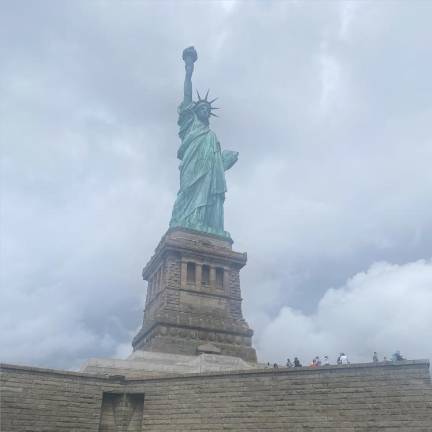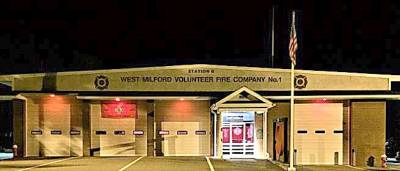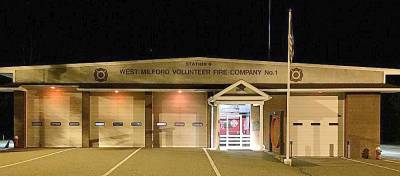West Milford man helped refurbish the Statue of Liberty in the 1980s
West Milford. Paul Emilius and his GEOD Company located in the Newfoundland section of the Township of West Milford helped restore the Statue of Liberty for the 100th anniversary of its dedication. It will celebrate its 136th anniversary on Oct. 28

This article was update 10/29/24.
The Statue of Liberty has reopened to visitors for the first time since the very early days of the coronavirus pandemic – just in time for the celebration of the 136th anniversary observance of dedication of the statue in 1886.
Memories of many readers may go back to 1986 when a memorable four-day Fourth of July celebration in New York Harbor included observance of the100th anniversary of France’s gift of the statue to the United States. What may not be well known is that a Newfoundland man and his company played a significant part in the work of restoring the historic statue. Having weathered winter storms, summer heat waves, sea air and even some graffiti, it was more than obvious the elements had taken their toll on the statue.
There was much work to be done with the first natural thing to do being to look at the original plans for the statue. The problem with that was there were no plan or copies of them to be found anywhere. Workmen put up scaffolding in January 1894 but there no definite plans as to how the project would move forward.
Somehow Paul Emilius and his GEOD Company located in the Newfoundland section of the Township of West Milford came to the rescue. They took measurement of the copper statue (151 feet 1 inch tall – 46 meters) and from the ground level to the torch 305 feet 1 inch tall) as the initial step. They used lasers, three dimensional photos and computers to provide engineers the figures they needed to put a small emergency elevator inside the statue. GEOD also provided exact computer readings to the craftsmen who made copper replicas of the statue’s face and left foot.
Emilius started his Emilius Associates business in the Oak Ridge section of the township in 1960. Under his leadership the firm expanded and became GEOD Companies – a network of companies providing land surveying and photogrammetory Services in New Jersey and Massachussetts. Not only did Emilius work on the statue project, but he also did land surveys for work involving the Brooklyn Bridge, Manhattan Bridge, World Trade Center site and most major highways in New Jersey.
Born in Manhattan and raised in Yonkers, he married Joan Brennan Emilius in Yonkers. They moved to West Milford and raised seven children. He was an Army reservist with the 332nd Engineer Aviation Battalion during the Korean War. Paul and Joan were married 62 years. He was a member of the Knights of Columbus and was a community leader while living in West Milford. The couple moved to Sparta after their children grew up and had their own lives and families. Paul died at age 86 on April 3, 2016.
Adults who were children at the time may remember being part of the contingent of school children who responded to the campaign coordinated by a Statue of Liberty-Ellis Island Centennial Commission headed by Chrysler Corp. head Lee Iacocca. Projects in New Jersey schools ranged from collecting pennies to fairs, plays and other events to help finance the statue refurbishing project.
Teachers who were employed by the West Milford Board of Education may remember the New Jersey Education Association (NJEA) endorsement of the project urging members and schools to become involved and “Save the Lady.” Peter Massardo, Jr. of the West Milford staff and State Education Commissioner Saul Cooperman were members of the National Education Advisory Committee to the Statue of Liberty-Ellis Island Centennial Commission.
According to the National Park Service the idea of a monument presented by the French people to the United States was initially proposed by Edouard Rene DE Laboulaye, President of the French Anti-Slavery Society. He was a law professor, politician and a prominent thinker of this time.
The Park report says the project is traced to a mid-1865 conversation between DE Laboulaye, a staunch abolitionist, and Frederick Bartholdi, French sculptor who would design the statue. (If Bartholdi’s name sounds familiar it is because a street in the adjacent Borough of Butler is named for him and Richard Butler, who that town is named for was a friend of Bartholdi’s.)
The statue is a figure of Libertas, a robed Roman liberty goddess, according to the park website. She holds a torch above her head with her right hand. Her left hand carries a tablet with July 4, 1776, the date of the US Declaration of Independence in Roman numerals. A broken shackle and chain lie at her feet as she walks forward commemorating the national abolition of slavery. The statue became an icon of freedom and symbol of welcome to immigrants arriving by sea.
The statue was administered by the US Lighthouse Board until 1901 and then by the Department of War. Since 1933 it has been maintained by the National Park Service. The statue was designated a national monument in 1924.

